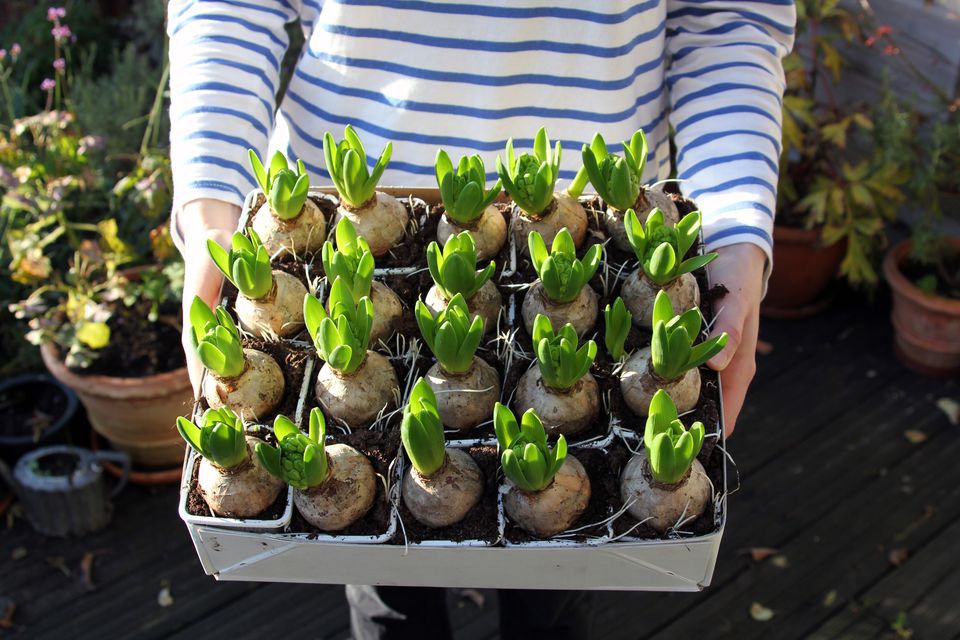Tulips, daffodils and hyacinths are all spring bloomers. It’s time to get those bulbs in the ground.
How to Plant Spring Flowering Bulbs
:max_bytes(150000):strip_icc()/woman-holding-box-of-hyacinth-bulbs-108138464-5b2d9fe7119fa800361eba44.jpg)
Spring flowering bulbs offer a reliable colorful display just when you need it most and they require very little effort. From which end is up, to when to feed, here are some spring bulb planting tips.
How to Plant Spring Bulbs
- Start by choosing healthy bulbs. Avoid bulbs that are withered, spongy or moldy. In general, the larger the bulb for its type, the more flowers. Small bulbs are less expensive and will have smaller or fewer flowers, but if you can be patient, they will mature in 3 o4 4 years.
- Choose an appropriate location. Most flowering bulbs prefer full sun, but that can be almost anywhere in the spring, before the trees leaf out. So don’t overlook a spot that seems perfect, just because it’s a bit shady in the fall. Woodland bulbs like Anemone nemorosa (Woodland Anemone), Arisaema (Jack-in-the-Pulpit), Erythronium (Dog’s Tooth Violets), Galanthus (Snowdrops) and Trillium, prefer a bit of cool shade.
- Bulbs do not like sitting in wet soil, especially when they are dormant in the summer. Choose a spot with well-drained, to prevent rotting.
- In areas with cold winters, you can plant bulbs as long as the soil is soft enough to dig a hole. However they will have more time to begin growing roots if planted before mid-November.In areas without a freezing winter, you may need to purchase pre-chilled bulbs, but you won’t have to plant your bulbs until early spring.
- Plant with the pointed side up. The pointed end is the stem. You may even be able to see some shriveled roots on the flatter side. If you really can’t tell, don’t worry about it. The stem will find it’s own way, sooner or later. You can hedge your bets and plant them sideways.
In your busy and connected life, the best time to prepare for an emergency is before it happens. Even careful, conscientious drivers can experience the unexpected out on the road.
Learn More
- Plant bulbs to a depth of about 3 times their diameter. For daffodils, that’s about 6 – 8 inches. Smaller bulbs can be planted to a depth of 3-4 inches and so on.
- Mix some bone meal or superphosphate into the soil at the bottom of the hole at planting time, to encourage strong root growth. You could mix in some water soluble fertilizer as well, but it’s not necessary if you’ve already amended your soil.
- If rodents tend to eat your bulbs, you can try sprinkling some red pepper in the planting hole. A more secure method is to plant your bulbs in a cage made of hardware cloth. The roots and stems grow through, but the rodents can’t get to the bulbs. Make it easy on yourself and make a cage large enough to plant at least a dozen bulbs. Or you can make it really easy on yourself and stick to daffodils, which rodents and most other animals avoid.
- Replace the soil on top of the bulbs. Water the bulbs after planting, to help them settle in and close any air pockets. Through the fall and winter, you only need to worry about watering your bulbs if you’re having a particularly dry season. Come spring, you should be well rewarded for all your efforts.
More Tips for a Great Bulb Display
- For A Natural Effect: Bulbs look best in clumps or drifts. To get a natural looking effect, either dig a large area and plant several bulbs at once or simply toss the bulbs into the air and dig holes and plant wherever they fall. You’ll be surprised how well this works.
- Mark Your Plantings: To make sure you don’t disturb your bulbs by trying to plant something in the same spot, mark where and what you have planted.
- Spring Care: When your bulbs have finished flowering, cut back the flower stalks to ground level. It can get ugly, but let the foliage of your flowering bulbs die back naturally. Resist the temptation to cut it back while still green, but floppy. The bulb needs this time to photosynthesize and make food reserves to produce next year’s flowers. Here’s more on when it’s safe to trim bulb leaves.
- To Divide Bulbs: Many bulbs spread and increase, making the original planting over crowded. If your bulbs are not flowering as well as they used to, this is probably the case. If you wish to move or divide your flowering bulbs, the safest time is when they enter their dormant period. This is usually just after the foliage completely dies back. Dormancy is brief, even though nothing is happening above ground, so don’t put this task off.

